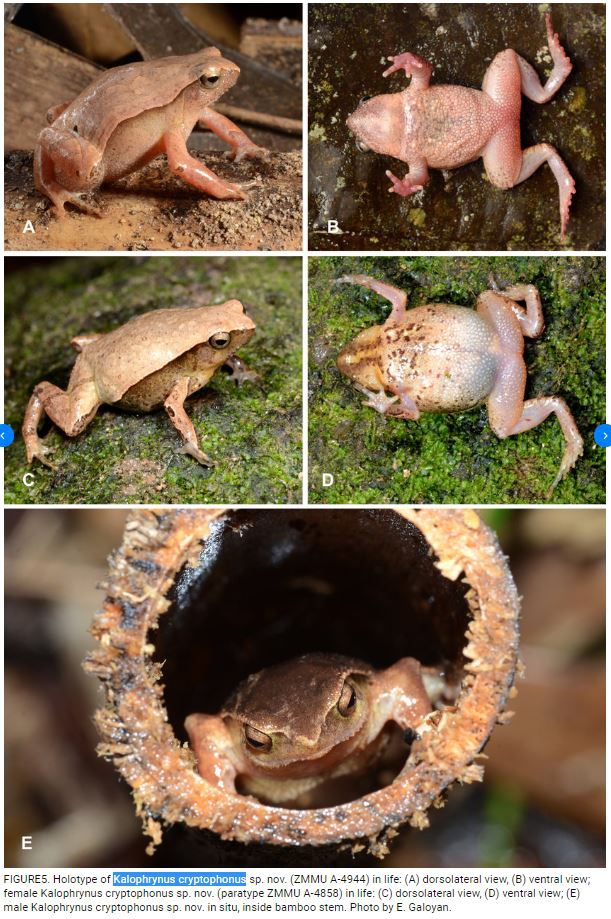| Citation |
IUCN SSC Amphibian Specialist Group 2016. Kalophrynus cryptophonus. The IUCN Red List of Threatened Species 2016: e.T73726605A73726619. http://dx.doi.org/10.2305/IUCN.UK.2016-3.RLTS.T73726605A73726619.en. Downloaded on 09 May 2019. |
Description |
Geographic Range
NATIVE
Extant (resident)
Viet Nam
NUMBER OF LOCATIONS
2
UPPER ELEVATION LIMIT
800 metres
LOWER ELEVATION LIMIT
247 metres
Geographic Range in detail
ESTIMATED AREA OF OCCUPANCY (AOO) (KM²)
CONTINUING DECLINE IN AREA OF OCCUPANCY (AOO)
EXTREME FLUCTUATIONS IN AREA OF OCCUPANCY (AOO)
ESTIMATED EXTENT OF OCCURRENCE (EOO) (KM²)
5438
CONTINUING DECLINE IN EXTENT OF OCCURRENCE (EOO)
EXTREME FLUCTUATIONS IN EXTENT OF OCCURRENCE (EOO)
CONTINUING DECLINE IN NUMBER OF LOCATIONS
EXTREME FLUCTUATIONS IN THE NUMBER OF LOCATIONS
RANGE DESCRIPTION
This species is currently known from between 247-800 m asl in the Southern Annamite Mountains in Loc Bao (Vassilieva et al. 2014) and Cat Tien National Park, Lam Dong Province, Viet Nam (Vassilieva et al. unpub. data). The limits of the species range are not known, however further surveys may reveal its presence in adjacent areas of similar elevation and habitat-type including parts of Binh Phuoc, Dak Nong and Binh Thuan Provinces. Its range has therefore been projected beyond known sites to include these areas of suitable habitat. The species estimated extent of occurrence (EOO) is 5,438 km2, and represents only two threat-defined locations.
Population
CURRENT POPULATION TREND
Decreasing
NUMBER OF MATURE INDIVIDUALS
POPULATION SEVERELY FRAGMENTED
CONTINUING DECLINE OF MATURE INDIVIDUALS
Population in detail
EXTREME FLUCTUATIONS
NO. OF SUBPOPULATIONS
CONTINUING DECLINE IN SUBPOPULATIONS
EXTREME FLUCTUATIONS IN SUBPOPULATIONS
ALL INDIVIDUALS IN ONE SUBPOPULATION
NO. OF INDIVIDUALS IN LARGEST SUBPOPULATION
DESCRIPTION
Very little is known about the size and trends of this species population except that it was described from five adult males, one adult female and 11 larvae at Loc Bao (Vassilieva et al. 2014), and an unspecified number of individuals were observed at Cat Tien National Park (Vassilieva et al. unpub. data). It is likely that the population is in decline due to the effects of forestry and agriculture on the species habitat. Further surveys are needed to determine its true range and population trends.
Habitat and Ecology
SYSTEM
Terrestrial
HABITAT TYPE
Forest
GENERATION LENGTH (YEARS)
CONGREGATORY
MOVEMENT PATTERNS
Not a Migrant
CONTINUING DECLINE IN AREA, EXTENT AND/OR QUALITY OF HABITAT
Yes
Habitat and Ecology in detail
HABITAT AND ECOLOGY
This species is associated with mixed evergreen forest composed prominently of bamboo (Vassilieva et al. 2014). It is a phytotelm breeder, and males call from within water-filled bamboo stems (Vassilieva et al. 2014). Eggs are presumably deposited within the stems as larvae have been observed inside them (Vassilieva et al. 2014). Much of this species life history remains unknown and further research is needed to determine such information. The species known habitat is disturbed and degradation due to forestry (and probably agriculture) is ongoing (Vassilieva et al. 2014).
CLASSIFICATION SCHEME
Habitats Suitability Major importance
1. Forest 1.9. Forest - Subtropical/Tropical Moist Montane Suitable Yes
Threats
Agriculture & aquaculture
Annual & perennial non-timber crops
Biological resource use
Logging & wood harvesting
Threats in detail
THREATS
The habitat of this species type-locality is disturbed and is within the Loc Bac Forestry Enterprise (Vassilieva et al. 2014). Much of its estimated range is bordered by land cleared for agriculture and is very likely being affected by this; thus the species is threatened by continuous removal and conversion of its habitat.
CLASSIFICATION SCHEME
Threats Timing Stresses Scope Severity Impact score Invasive species Virus
2. Agriculture & aquaculture 2.1. Annual & perennial non-timber crops 2.1.3. Agro-industry farming Ongoing
1. Ecosystem stresses 1.1. Ecosystem conversion
1.2. Ecosystem degradation
2. Species Stresses 2.2. Species disturbance
2.3. Indirect species effects 2.3.7. Reduced reproductive success
Unknown Unknown Unknown
5. Biological resource use 5.3. Logging & wood harvesting 5.3.3. Unintentional effects: (subsistence/small scale) [harvest] Ongoing
1. Ecosystem stresses 1.1. Ecosystem conversion
1.2. Ecosystem degradation
2. Species Stresses 2.1. Species mortality
2.2. Species disturbance
2.3. Indirect species effects 2.3.7. Reduced reproductive success
|

